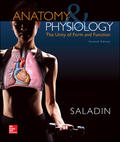
Concept explainers
Introduction:
The taste sense is also referred to as gustation, which begins with the taste buds (about 4000). The taste buds are composed of sensory cells that are involved in chemical stimulation. These taste buds are lemon shaped group of cells (50 to 150) and include supporting cells, taste cells, and basal cells. The gustatory or taste cells are nearly banana shaped and possess a tuft of microvilli (apical) referred to as taste hairs, works as receptor surfaces for the
Want to see the full answer?
Check out a sample textbook solution
Chapter 16 Solutions
EBK ANATOMY & PHYSIOLOGY: THE UNITY OF
- Which of the following statements are true of the parts of the eye? (Read carefully and select all the correct statements.) A. Vitreous humor is reabsorbed into the canal of Schlemm. B. The radial muscles of the iris constrict the pupil. C. The white of the eye is formed by the sclera. D. The choroid layer absorbs light within the eyeball. E. The conjunctiva is kept moist by tears secreted by the lacrimal glands. F. The retina is the innermost layer of the eyeball. G. The ciliary muscle is a circular smooth muscle that changes the shape of the cornea. H. Aqueous humor is the tissue fluid of the eye; it nourishes the lens and cornea.arrow_forwardWhich statements is/are true? a. The test substances can only be determined in their specific area according to the taste map of thetongue.b. The test substances can be determined anywhere in the tongue.c. The middle of the tongue cannot taste any of the substances.d. The salt solution is the only substances that could be determined in the middle of the tongue.e. Intensity of the taste of the substances are different form every area of the tongue.arrow_forwardWhich of the following statements is true? a. Specific taste buds are located in each area of the tongue thus, can only determine a specific taste.b. The middle tongue contains taste buds which can only determine salty taste.c. The taste buds can determine all taste, but are located in different areas and different quantities on thetongue.d. Taste buds contain gustatory cells specific for a certain taste.arrow_forward
- Taste cellsa. are found only on the tongue.b. extend through tiny openings called taste buds.c. have no axons but release neurotransmitters when stimulated.d. have axons that extend directly to the taste area of the cerebralcortex.arrow_forwardChoose the structure that applies to each statement. a. cribriform plate b. superior portion of nasal cavity c. olfactory hair d. olfactory nerve e. olfactory receptor cells 1. bipolar neurons 2. part of olfactory receptor cell that contains the olfactory receptors 3. formed of bipolar neuron axons 4. olfactory nerves pass through this structure before synapsing onto olfactory bulb 5. location of the olfactory epitheliumarrow_forwardWhich of the following statements is true regarding gustatory cells? a. They have microvilli that project into the taste pore. b. There are only 10–20 gustatory cells in a typical taste bud. c. They have a lifespan of approximately 6 months. d. Some form synapses with neurons that give rise to the trigeminal nerve.arrow_forward
- Olfactory sensory neurons have olfactory ______ that extend outward from the epithelium for conveying impulses in sensation of smell. A. papillae B. supporting cells C. olfactory epithelium D. cilia What chemicals would elicit the bitter taste sensation? A. alkaloids B. metal ions C. hydorgen ions D. glutamate Sound waves that enter the external auditory meatus will encounter the ______, which vibrates at exactly the same frequency as the sound waves hitting it? A. ceruminous glands B. tympanic membrane C. auricle D. scala tympaniarrow_forwardWhich of these statements is not true with respect to olfaction?a. Olfactory sensation is relayed directly to the cerebral cortex withoutpassing through the thalamus.b. Olfactory neurons are replaced about every 2 months.c. The olfactory cortex is involved in the conscious perception of smell.d. The secondary olfactory areas are responsible for visceral andemotional reactions to odors.e. The olfactory cortex is in the occipital lobe of the cerebrum.arrow_forwardWhich of these is not one of the basic tastes?a. spicy b. salt c. bitter d. umami e. sourarrow_forward
- In humans, most olfactory cells are located in thea. nasal cavity.b. nostrils.c. pharynx.d. roof of the mouth.arrow_forwardOlfactory bulbs are locateda. on the tongue.b. in the nasal cavity.c. in the brain stem.d. in the aorta.e. None of these are correct.arrow_forwardWhich two of the following are part of the olfactory organs? a. olfactory receptor cells b. columnar epithelial cells in the nasal mucosa c. the brain d. the eyesarrow_forward

